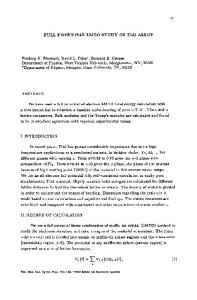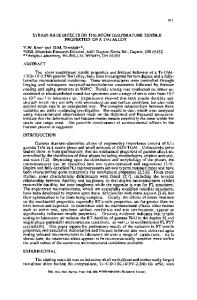Mechanical Properties of the TiAl IRIS Alloy
- PDF / 2,806,626 Bytes
- 12 Pages / 593.972 x 792 pts Page_size
- 83 Downloads / 352 Views
RODUCTION
AFTER several decades of research, TiAl low-pressure turbine (LPT) blades are now implemented in the new generation of aircraft engines by several companies such as the GEnX of GENERAL ELECTRIC and the LEAP of SNECMA-SAFRAN. Such LPT blades are produced with the commercial 48-2-2 alloy (Ti-48Al-2Cr-2Nb) by investment casting or ingot machining, resulting in a duplex microstructure. The TiAl blade implementation is at present limited to the last low-pressure stages of these engines and a real breakthrough in the mechanical properties is required for their introduction into hotter stages. In the recent past, several competitive routes have been investigated in order to develop both an alloy composition having enhanced properties and a process for manufacturing aero-engine components. This includes for instance forging of TNM alloys (Ti-(41-45)Al-4Nb-1Mo-0.1B at. pct)[1] or extrusion of THOMAS VOISIN, Postdoctoral Researcher, is with the CNRS; CEMES (Centre d’Elaboration de Mate´riaux et d’Etudes Structurales); BP 94347, 29 Rue J. Marvig, 31055, Toulouse, France, and also with the Department of Materials Science and Engineering, Johns Hopkins University, Baltimore, MD 21218. JEAN-PHILIPPE MONCHOUX and ALAIN COURET, Researchers, and CHRISTOPHE DESHAYES, Technician, are with the CNRS; CEMES (Centre d’Elaboration de Mate´riaux et d’Etudes Structurales). Contact e-mail: [email protected]. MARC THOMAS, Ingenior, is with ONERA/DMSM, 29 Avenue de la Division Leclerc, BP 72, 92322 Chaˆtillon Cedex, France. Manuscript submitted April 8, 2016. Article published online October 20, 2016 METALLURGICAL AND MATERIALS TRANSACTIONS A
TNB alloys (Ti-(42-45)Al-(5-10)Nb-(0-0.5)B at. pct).[2] More recently, the electron beam melting (EBM) technique associated with powder metallurgy is attracting some interest for part manufacturing with a high buy-to-fly ratio.[3] In this context, an alternative processing route is currently explored by the CEMES institute, based on a Powder Metallurgy (PM) approach with Spark Plasma Sintering (SPS), thereby leading to texture-free alloys with homogenous microstructures.[4] Using the so-called IRIS alloy with the Ti-48Al-2W-0.08B composition, a fine near-lamellar microstructure has been obtained by SPS processing in super-transus conditions, i.e., samples were heated, during the SPS cycle, in the a + b field, above the a + b + c/a + b line transformation (one can find the phase diagram corresponding to the specific composition of the IRIS alloy in the following References 5,6). Its as-densified microstructure consists of small lamellar colonies, with a grain size of 35 to 45 lm, surrounded by c borders containing b0 precipitates. The width of the c border varies between 5 and 10 lm.[6] In this paper, mechanical properties of the IRIS-SPS alloy are studied in a wide temperature range. Complementary investigations are carried out on the microstructural features and on the elementary deformation mechanisms in order to establish some relationships with the mechanical properties. The latter are evaluat
Data Loading...











